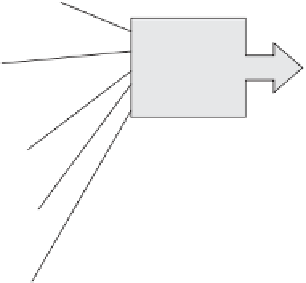Database Reference
In-Depth Information
REALITY
DATA MODEL
Emergency Room Information
Number of patients waiting
Nurses in attendance
Patient's medical condition
Doctors in attendance
Patient's diagnosis
Color of the walls
Drop ceiling pattern
Services to the patient
Overall lighting
Patient's insurance coverage
Music over the speakers
Patient Name, SSNo.
……………………………
Billing for
Emergency Services
Patient's medical condition
Patient's diagnosis
Services to the patient
Patient's insurance coverage
Patient Name, SSNo.
……………………………
Filtering /
Mapping
Functions
A data model is a true representation
or replica of reality that contains only
the selected details.
Figure 5-7
Mapping of data model components.
The next step is to formulate the logical design of the proposed database. As you
know, the logical design consists of the conceptual view of the database. We referred
to the output of the logical design step as the conceptual schema of the database.
The conceptual schema provides a representation of the entire database, its struc-
ture, the relationships among the data structures, and any constraints. Well, how does
the conceptual schema differ from the data model you have created up to this step?
The essential difference lies in their basic nature. The data model created up to this
step is a generic model built with building blocks independent of any conventional
models. Remember that the conventional data models are the hierarchical, network,
and relational models. In these models, the data structures and relationships are por-
trayed with certain defined arrangements—as hierarchical segments, network nodes,
or two-dimensional tables.
Let us summarize the steps up to this point:
1. Requirements definition
2. Filtering out of irrelevant details
3. Creation of generic data model
4. Transformation into selected conventional model (hierarchical, network,
relational, etc.)
Before we discuss the types of data models and describe their patterns, let us
introduce the placement of these models in the database development life cycle.
Figure 5-8 shows the phases in which the different types of models are created. Just
note the different types of models indicated in the figure. The essential nature of
each type is described in the next section.




Search WWH ::

Custom Search